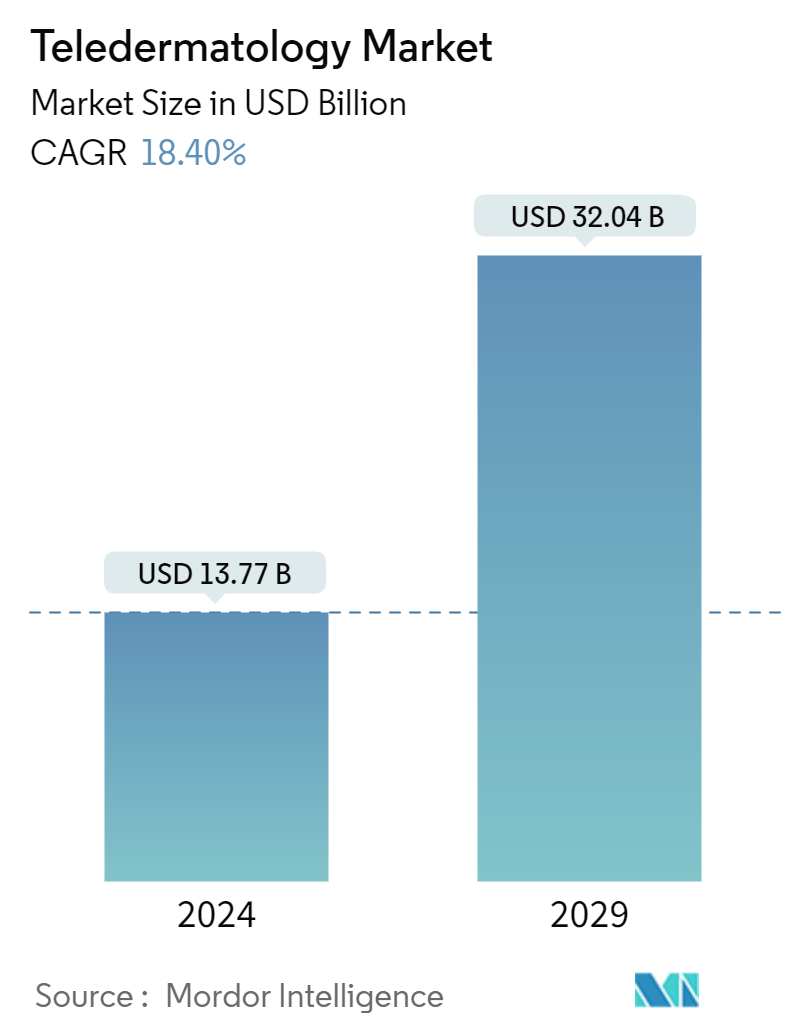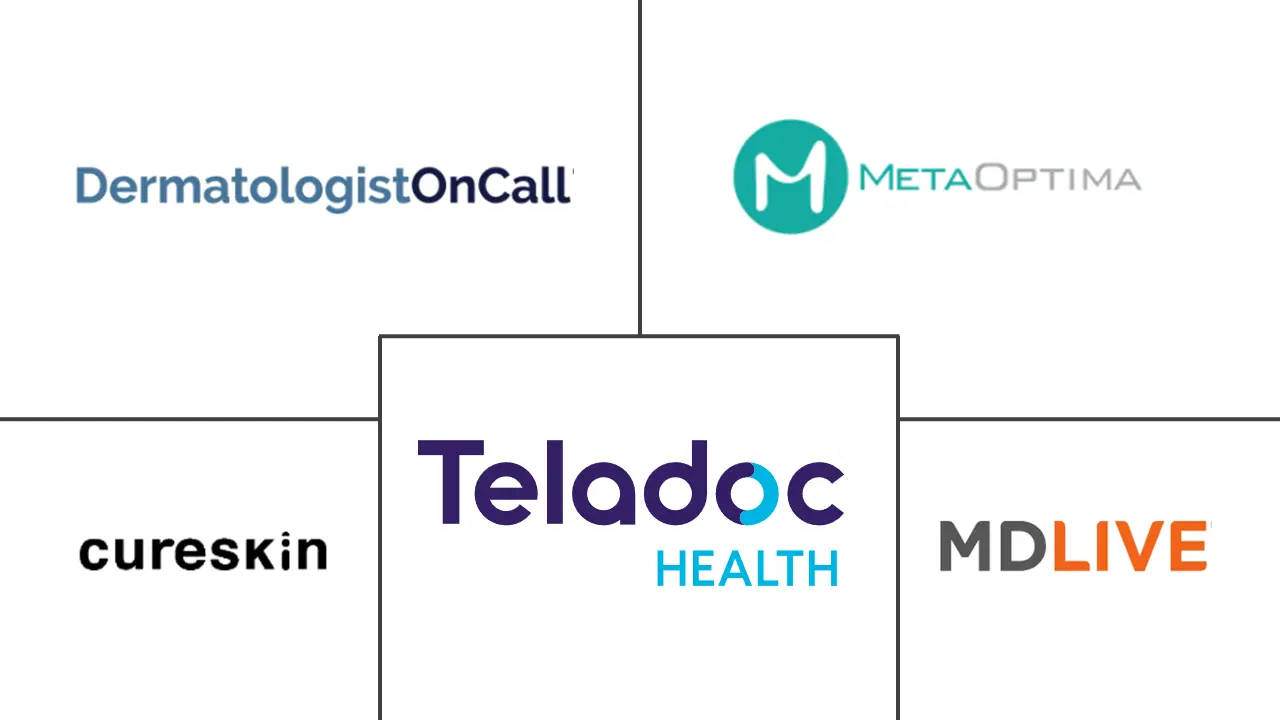Market Size of Teledermatology Industry

| Study Period | 2019 - 2029 |
| Market Size (2024) | USD 13.77 Billion |
| Market Size (2029) | USD 32.04 Billion |
| CAGR (2024 - 2029) | 18.40 % |
| Fastest Growing Market | Asia Pacific |
| Largest Market | North America |
Major Players
*Disclaimer: Major Players sorted in no particular order |
Teledermatology Market Analysis
The Teledermatology Market size is estimated at USD 13.77 billion in 2024, and is expected to reach USD 32.04 billion by 2029, growing at a CAGR of 18.40% during the forecast period (2024-2029).
Teledermatology is a subfield of telemedicine that uses telecommunication technology to provide dermatology care remotely. It enables the exchange of images and medical information through secure platforms for evaluation and diagnosis and remotely offers treatment to patients with skin problems. The demand for teledermatology is increasing with the rise of the digital age and improving access to dermatological care, particularly in remote and underserved areas. The lack of dermatologists and the increasing incidence of skin conditions such as psoriasis, eczema, and acne are surging the demand for teledermatology. For instance, according to an article published by the British Skin Foundation in November 2023, currently, there are around 2,000 different dermatological conditions, and teledermatology can address around 90% of them, including skin cancer. Moreover, the convenience, accessibility, and cost-effectiveness of teledermatology offered to patients and healthcare providers are significant factors influencing market growth.
Furthermore, the lack of dermatologists and limited access to dermatology care in low- and middle-income countries due to geographical barriers, long waiting times, and mobility issues are surging the adoption rate of teledermatology, subsequently fueling the market growth. For instance, in a study published by the Indian Journal of Dermatology, Venereology, and Leprology in December 2023, there was less than one dermatologist per million population in sub-Saharan Africa in 2022. In contrast, there were 34 dermatologists per million population in the United States in 2022. Hence, teledermatology is a powerful educational and clinical support tool for diagnosing and managing skin diseases in countries lacking dermatologists. Implementing this technology to improve access to dermatology care will drive market growth over the coming years.
In addition, technological advancements introduced by market players in the teledermatology systems to provide more accurate diagnosis and treatment recommendations, coupled with more advanced imaging and data analysis capabilities, are expected to fuel the market growth. For instance, in September 2022, MCI Onehealth Technologies Inc., a healthcare technology company, and Oro Health, an artificial intelligence solution provider, collaboratively developed and launched the MCI Dermatology Connect platform. The platform provides specific solutions for virtual dermatology care, including secure transfer of high-resolution imaging between patient and specialist. The comfort and benefits that teledermatology offers over long wait times for in-person visits are anticipated to drive the demand for teledermatology between 2024 and 2029.
However, privacy and security concerns, lack of adherence to the regulatory framework, and lack of reimbursement facilities in emerging countries are expected to restrain the market growth from 2024 to 2029.
Teledermatology Industry Segmentation
Teledermatology is a branch of telemedicine that uses telecommunication technology to provide dermatological care remotely. It involves using video conferencing, digital imaging, and other telecommunication tools to diagnose and treat skin conditions. The teledermatology market is segmented into component, modality, end user, and geography. By component, the market is segmented into products and services. By modality, the market is segmented into store and forward, real-time, and hybrid. By end user, the market is segmented into hospitals, dermatology clinics, and home care. By geography, the market is segmented into North America, Europe, Asia-Pacific, Middle East and Africa, and South America. The report also offers the market size and forecasts for 17 countries across the regions. For each segment, the market sizing and forecasts have been done on the basis of value (USD).
| By Component | |
| Products | |
| Services |
| By Modality | |
| Store and Forward | |
| Real Time | |
| Hybrid |
| By End User | |
| Hospitals | |
| Dermatology Clinics | |
| Homecare |
| Geography | ||||||||
| ||||||||
| ||||||||
| ||||||||
| ||||||||
|
Teledermatology Market Size Summary
The teledermatology market is poised for significant growth, driven by the increasing demand for remote dermatological care facilitated by advancements in telecommunication technology. This subfield of telemedicine enables the secure exchange of medical information and images, allowing for remote evaluation, diagnosis, and treatment of skin conditions. The rising incidence of skin disorders, coupled with a shortage of dermatologists, particularly in remote and underserved regions, is propelling the adoption of teledermatology. The convenience, accessibility, and cost-effectiveness of these services are key factors contributing to market expansion. Technological innovations, such as advanced imaging and data analysis capabilities, further enhance the accuracy of diagnoses and treatment recommendations, supporting the market's growth trajectory.
The market landscape is characterized by a fragmented competitive environment, with numerous global and regional players offering a variety of teledermatology solutions. North America is expected to hold a significant market share due to the rapid acceptance of telehealth services and the presence of established healthcare infrastructure. Initiatives by government and non-government organizations to raise awareness and improve access to dermatological care are also driving market growth. Strategic partnerships and expansions by key players, along with increased funding for teledermatology programs, are creating new opportunities in the market. Despite challenges such as privacy concerns and regulatory hurdles, the teledermatology market is anticipated to experience robust growth, with a focus on enhancing patient engagement and improving health outcomes.
Teledermatology Market Size - Table of Contents
-
1. MARKET DYNAMICS
-
1.1 Market Overview
-
1.2 Market Drivers
-
1.2.1 Increasing Burden of Skin Conditions
-
1.2.2 Increasing Adoption of Telehealth Platforms
-
1.2.3 Technological Advancements in Telemedicine
-
-
1.3 Market Restraints
-
1.3.1 Privacy and Security Concerns
-
1.3.2 Lack of Reimbursement Facilities in Emerging Countries
-
-
1.4 Porter's Five Forces Analysis
-
1.4.1 Threat of New Entrants
-
1.4.2 Bargaining Power of Buyers/Consumers
-
1.4.3 Bargaining Power of Suppliers
-
1.4.4 Threat of Substitute Products
-
1.4.5 Intensity of Competitive Rivalry
-
-
-
2. MARKET SEGMENTATION (Market Size by Value - USD)
-
2.1 By Component
-
2.1.1 Products
-
2.1.2 Services
-
-
2.2 By Modality
-
2.2.1 Store and Forward
-
2.2.2 Real Time
-
2.2.3 Hybrid
-
-
2.3 By End User
-
2.3.1 Hospitals
-
2.3.2 Dermatology Clinics
-
2.3.3 Homecare
-
-
2.4 Geography
-
2.4.1 North America
-
2.4.1.1 United States
-
2.4.1.2 Canada
-
2.4.1.3 Mexico
-
-
2.4.2 Europe
-
2.4.2.1 Germany
-
2.4.2.2 United Kingdom
-
2.4.2.3 France
-
2.4.2.4 Italy
-
2.4.2.5 Spain
-
2.4.2.6 Rest of Europe
-
-
2.4.3 Asia-Pacific
-
2.4.3.1 China
-
2.4.3.2 Japan
-
2.4.3.3 India
-
2.4.3.4 Australia
-
2.4.3.5 South Korea
-
2.4.3.6 Rest of Asia-Pacific
-
-
2.4.4 Middle East and Africa
-
2.4.4.1 GCC
-
2.4.4.2 South Africa
-
2.4.4.3 Rest of Middle East and Africa
-
-
2.4.5 South America
-
2.4.5.1 Brazil
-
2.4.5.2 Argentina
-
2.4.5.3 Rest of South America
-
-
-
Teledermatology Market Size FAQs
How big is the Teledermatology Market?
The Teledermatology Market size is expected to reach USD 13.77 billion in 2024 and grow at a CAGR of 18.40% to reach USD 32.04 billion by 2029.
What is the current Teledermatology Market size?
In 2024, the Teledermatology Market size is expected to reach USD 13.77 billion.

